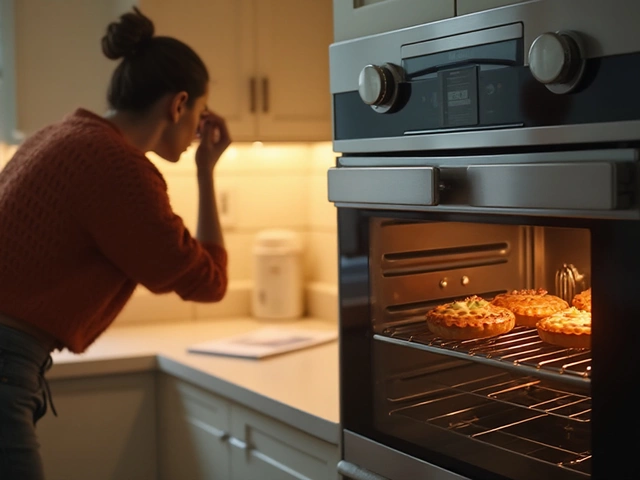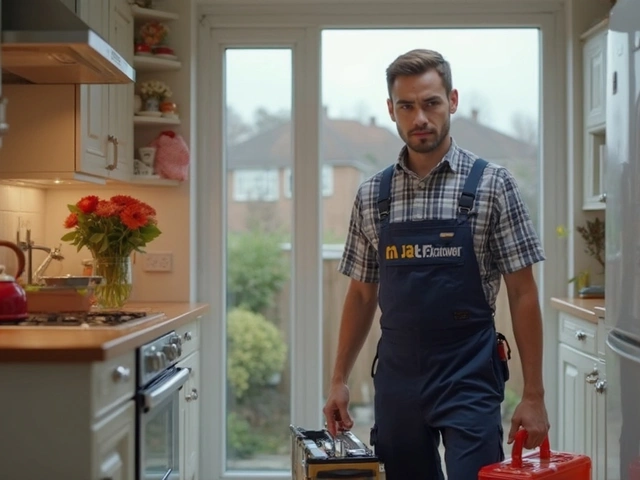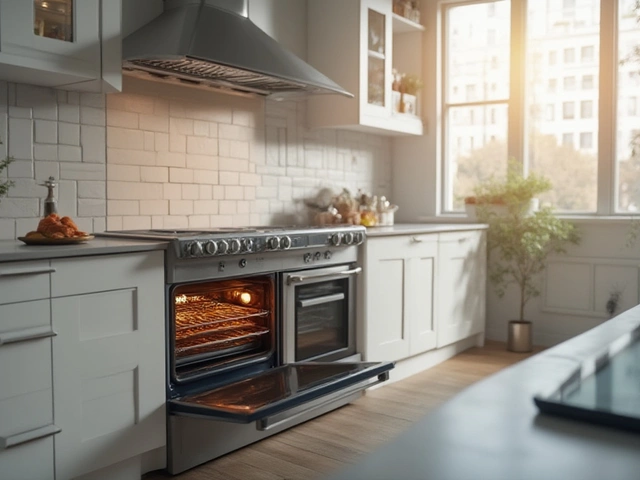If an oven could talk, what wild stories would a 20-year-old one tell? It’s likely seen hundreds of burnt pizzas, holiday baking frenzies, science projects gone wrong, and late-night snacks with the kids. So when that vintage oven stops heating up, refuses to light, or spins a dial and gives you nothing but silence—should you try to revive it, or is it time to pull the plug? This question comes up constantly in homes, especially those with a bit of history, and there’s more to the answer than you’d think. Experts say the average oven is built to run about 13-17 years, but plenty of folks (myself included) have one that blows past the expected finish line. Thing is, figuring out whether that ancient appliance can be saved takes a mix of detective work, resourcefulness, and sometimes just a little parental stubbornness—my daughter Callista can tell you all about her dad’s adventures with stubborn old tech. Before you toss it or call in the pros, let’s look at what really goes into bringing a classic oven back from the brink.
What Fails on an Old Oven, Really?
Old ovens are tanks compared to a lot of today’s shiny gadgets. Decades back, manufacturers used heavier-duty metal, beefier wiring, and fewer finicky digital components, which is why your grandma’s range might outlive five new smartphones. But time is relentless. Heating elements crack, thermostats lose calibration, dials wear down, control boards fry, and gaskets become stiff and crumbly. On gas models, igniters and safety valves can fizzle out. Joints may collect layers of carbonized grease, warping oven doors or preventing proper temperature control.
One big thing people don’t realize: older ovens often have fewer computerized parts, so failures are usually physical, not electronic. If your oven doesn’t heat up, it’s usually a $30 element or a fried relay rather than a mysterious microchip. Parts like bake and broil elements, igniters, fuses, thermostats, and oven light bulbs are still surprisingly easy to replace and often available at appliance stores or online.
Yet, sometimes it’s the simple mechanical components that conk out—a stuck door latch, warped racks, a busted timer knob. Even hinges can fail, causing heat to leak and cooking to be unreliable. These all sound small, but one failed component can render your oven useless.
Check out this table of common failures and potential costs for a 20-year-old oven. Numbers are average prices—actuals might be higher or lower depending on your area and oven model:
| Part/Failure | Symptom | Avg. Replacement Cost (USD) |
|---|---|---|
| Bake Element (Electric) | No heating | $30–$90 |
| Igniter (Gas) | No flame or slow ignition | $40–$110 |
| Thermostat/Control | Bad temperature control | $60–$220 |
| Oven door gasket | Heat loss | $10–$60 |
| Electronic control board | Dead oven | $200–$400 |
| Timer/Clock | Nonfunctional timer | $50–$180 |
| Hinges/Racks | Door won’t close, uneven baking | $10–$70 |
What makes repairs tough is when manufacturers discontinue parts, especially for obscure models. An independent parts shop can sometimes track down compatible pieces or used/refurbished options. A real wild card: repair shops might even scrounge for your old model at local appliance graveyards, if you’re willing to wait and pay a premium. Key tip—always check your oven’s model and serial number (usually on a sticker inside the door) before shopping for parts or even calling a tech.
How to Diagnose Common Problems on a 20-Year-Old Oven
Start simple—don’t assume the worst just because your old oven hiccups. There are easy steps to take before you call in anyone. First, double-check power and gas connections. Kids love to flip breakers accidentally during fort-building missions (ask Callista about my infamous fridge incident). If an electric oven is totally dead, make sure it’s plugged in and confirm the circuit breaker hasn’t tripped. On gas models, check that the pilot light isn’t out and the fuel supply is open.
For electric ovens that won’t heat, visually inspect the bake and broil elements. They’re usually at the top and bottom of the oven. If you see obvious cracks or burnt spots, that’s almost certainly your culprit. For about $30–$80 and a Phillips screwdriver, you can swap them out yourself. Plenty of solid YouTube videos show the steps. Always unplug before you touch anything electrical!
Gas ovens often fail from a $40–$90 igniter burning out. Does the oven make a clicking sound but never light? Does it take minutes instead of seconds to ignite? The igniter might glow but fail to spark enough to open the gas valve. Again, swapping these out is a beginner-friendly fix—even easier if you’re comfortable working with basic tools and tiny screws. If you smell gas, stop immediately and call a professional—don’t tinker further.
Is your oven temperature way off? Pick up an oven thermometer for about $10 and run a test at 350°F. If your oven over- or under-bakes by more than 25°F, the thermostat is likely failing. Old mechanical dials can drift, and sometimes recalibration is possible using a small screw behind the knob. For ovens with digital controls, the whole control board might need replacing.
Baking disaster because the door won’t close right? Try replacing the gasket or hinges before giving up. Even a slightly warped door leaks enough heat to ruin a casserole. Found a mysterious rattle or weird noise? Sometimes it’s just fallen debris (kids, pets, who knows) stuck inside the oven cavity.
If you need schematics, visit parts suppliers like RepairClinic, Sears PartsDirect, or appliance model support forums. Downloading a PDF manual for a 20-year-old oven might require some deep Googling—but I’ve had luck with the model number, even for late ’90s and early 2000s ranges.

The Real Costs: Repair Bills vs. Replacement
So, let’s talk money—because nothing stings like pouring $250 into repairs only to have another part fail a week later. Today (it’s July 2025 as I write this), the average appliance service call runs between $85 and $160 just for diagnosis. Parts and labor stack on top of that. A full repair for something major (control panel, serious wiring damage, burner assembly) can touch $400–$600 fast.
But compare that to new oven prices. The average standalone electric oven runs $650–$1,300, while gas models run $800 to $1,600 for a decent quality mid-range version. Add delivery, installation, and old appliance hauling (often not free these days), and you could be looking at $2,000 for a full swap. If you have a built-in wall oven, double those estimates—the labor to re-fit a non-standard opening costs real money. Some folks forget to factor in cabinet modifications or new electrical/gas lines, which can add hundreds.
Here’s a quick breakdown of when repairs “make sense” versus replacement, based on appliance industry advice:
- If the repair cost is less than half the price of a new oven—and the rest of your oven is in good shape—repair away.
- If your oven still functions safely, doesn’t leak gas/heat, and spares are available, it’s fair play for repairs.
- If multiple parts are failing each year, or you have multiple fixes topping $200, replacement starts to make more sense.
- If your oven is a specialty model (retro-color, commercial quality, fits a custom slot), even pricier repairs might be worth it.
Another thing people overlook: how much does the oven’s unreliability cost you in ruined food or stressful family dinners? My daughter can count more than one night my lasagna wound up partly raw, partly carbonized because an old thermostat gave up the ghost mid-bake. There’s a value to convenience and peace of mind that’s hard to put a dollar figure on, but it’s real. Do the numbers—and remember, sometimes sentimental value (like baking holiday cookies in grandma’s old oven) trumps budgets.
Tips for Getting Parts and Expert Help
Not every oven part is still made, but plenty are—especially for big-name brands like GE, Whirlpool, Frigidaire, and Kenmore. For rare models, hunting down parts is a bit of a scavenger hunt. I’ve found success in a few places:
- Major Appliance Stores Online: Websites like RepairClinic.com, PartSelect.com, and Sears PartsDirect let you search by model. If a part is discontinued, try checking the ‘used’ or ‘substitute’ options.
- Local Appliance Repair Shops: Old-timers at independent shops sometimes have secret stashes of out-of-production parts or know how to retrofit similar pieces from newer models.
- Online Marketplaces: eBay, Craigslist, Facebook Marketplace—sounds sketchy, but appliance parts harvesting is big business. You might snag NOS (new old stock) or used parts for pennies.
- Community Forums: Reddit’s r/appliancerepair and appliance-focused message boards are packed with DIYers and techs eager to help you track down that weird relay or custom rack.
- Direct from Manufacturer: Sometimes a call to the original manufacturer’s support line actually yields success—especially for commercial and higher-end models.
If you’re going the pro route, avoid big chains unless you want to pay premium rates. Local repair people often work on a broader range of brands and don’t mind tackling ‘obsolete’ models—as long as you’re not in a rush for hard-to-get parts. Ask for quotes up front and check references. If the tech says they can’t even FIND parts, walk away before you get a bill.
For vintage ovens (think avocado or harvest gold from the seventies, or those heavy 90s ranges), check with restoration specialists. There’s a whole subculture dedicated to saving retro appliances for historic homes, and they often know creative fixes to modernize safety while keeping that classic look.

Restoring an Old Oven: What’s Worth the Effort?
One reason people hang onto an old oven isn’t just cost—it’s nostalgia, especially if you cooked your first Thanksgiving turkey with it, or you and your kid baked your first lopsided cupcakes together (looking at you, Callista). A 20-year-old oven has lived through thousands of family meals. There’s a certain satisfaction in rolling up your sleeves, ordering a hard-to-find element, and bringing it back to life.
But where’s the line between smart restoration and stubborn foolishness? If your oven works, fits your kitchen, isn’t a fire or gas hazard, and has fixable parts, taking the DIY repair route is worth it. Cleaning out decades of grease, changing a couple gaskets, or recalibrating the thermostat might be enough to buy you several more years. On rare models, you might even increase the unit’s value to the right buyer—vintage appliances have a surprising collectors’ market.
Here are some steps for basic restoration anyone with patience and a YouTube tutorial can try:
- Deep clean inside and out. Pull racks, soak in warm soapy water, and tackle build-up on the oven walls with a mix of baking soda and vinegar. Don’t use harsh chemicals unless the manual says it’s safe.
- Inspect the wiring. Look for frayed or brittle wires, especially around the element connections. Replace wires with proper-hi temp appliance wire if needed.
- Replace commonly worn parts. New elements, oven gaskets, or knobs make a bigger difference than you’d expect.
- Calibrate the thermostat. Use a thermometer to test and, if mechanical, adjust via the dial screw. On digital ovens, see if the manual allows a user calibration sequence.
- Test for leaks. For gas ovens, soapy water around joints bubbles up if there’s a leak—never use matches. If you detect any gas smell, stop.
- Check insulation. If the sides of the oven get blazing hot, the internal insulation may have degraded—this is a job for a pro if you want to keep the oven safe and efficient.
Don’t underestimate the joy in getting a machine as old as some high school seniors working again. It’s a little like repairing an old bike with your kid: a lesson in resourcefulness and appreciating how things are built. Just recognize your limits—safety first, especially with gas or if you see evidence of burning inside the control panel. If the repair seems out of your skill set, call in a tech. Sometimes, the best thing you can do for your family’s safety is to admit when an appliance has outlived its useful life and send it off with gratitude.
So, can a 20-year-old oven be repaired? Most of the time, yes. If you can source parts, have a bit of know-how (or a willingness to learn), and the oven itself isn’t fundamentally unsafe, don’t write it off just because it’s old. Who knows, with a little luck (and maybe a new gasket), your next loaf of bread could taste a little like nostalgia—and a lot like victory.




